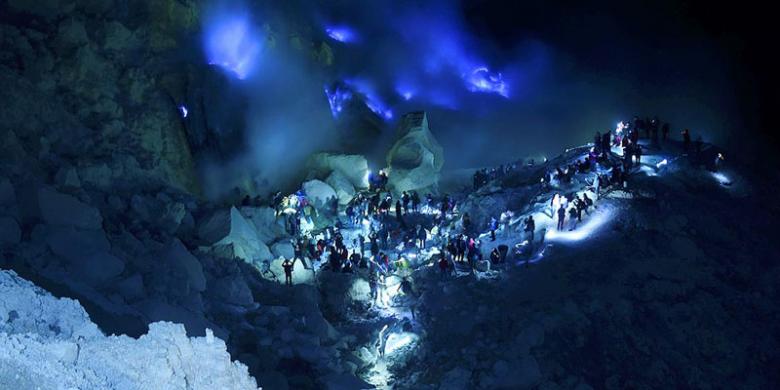Few years ago, an image went viral when French photographer Olivier Grunewald captured spectacular photos of Indonesia's Kawah Ijen volcano. Snapped during shooting of a new documentary he's releasing with the president of Geneva's Society for Volcanology, Régis Etienne, the photos—taken without the aid of any filter or digital enhancement—showcase the volcano's amazing electric blue glow.
Little of the web coverage, though, has enlightened readers on the scientific principles at work. "This blue glow, unusual for a volcano, isn't the lava itself, as unfortunately can be read on many websites," Grunewald says. "It is due to the combustion of sulfuric gases in contact with air at temperatures above 360°C."

In other words, the lava—molten rock that emerges from the Earth at ultra-high temperatures—isn't colored significantly differently than the lava at other volcanoes, which all differ slightly based on their mineral composition but appear a bright red or orange color in their molten state. But at Kawah Ijen, extremely high quantities of sulfuric gases emerge at high pressures and temperatures (sometimes in excess of 600°C) along with the lava.
Exposed to the oxygen present in air and sparked by lava, the sulfur burns readily, and its flames are bright blue. There's so much sulfur, Grunewald says, that at times it flows down the rock face as it burns, making it seem as though blue lava is spilling down the mountainside. But because only the flames are blue, rather than the lava itself, the effect is only visible at night—during daytime, the volcano looks like roughly any other.

"The vision of these flames at night is strange and extraordinary," Grunewald says. "After several nights in the crater, we felt really living on another planet."
Mt Ijen, located at the eastern tip of the island of Java, has two of the most unusual occurrences on Earth. In addition to its amazing blue flame, it also has one-kilometer-wide caldera lake filled with turquoise-blue water. The color of the water is a result of its extreme acidity and a high concentration of dissolved metals. It is the world's largest highly acidic lake with a measured pH as low as 0.5. The cause of its acidity is an inflow of hydrothermal waters charged with gases from a hot magma chamber below.

About 300,000 years ago, volcanic activity in this area began building a large stratovolcano that is called "Old Ijen" today. Over thousands of years and repeated eruptions, it grew to an elevation of about 10,000 feet. Lava flows and pyroclastic deposits from Old Ijen disconformably overly the Miocene limestone.
Then, about 50,000 years ago, a series of enormous explosive eruptions produced a caldera about ten miles in diameter. About twenty cubic miles of material was ejected and covered the surrounding landscape up to 300 to 500 feet deep in ejecta and volcanic ash.
In the past 50,000 years, many small stratovolcanoes have formed within Old Ijen's caldera and covered its southern and eastern margins. Kawah Ijen covers part of the eastern margin. Thousands of years of weathering have converted the pyroclastic deposits into rich, fertile soils which now support coffee plantations.

The volcano remains active. The last magmatic eruption occurred in 1817. Phreatic eruptions occurred in 1796, 1917, 1936, 1950, 1952, 1993, 1994, 1999, 2000, 2001, and 2002. These have caused very little damage but present a danger to anyone mining sulfur or visiting the caldera.
Source: swmithsonianmag.com | Nationalgeographic.com | geology.com



















